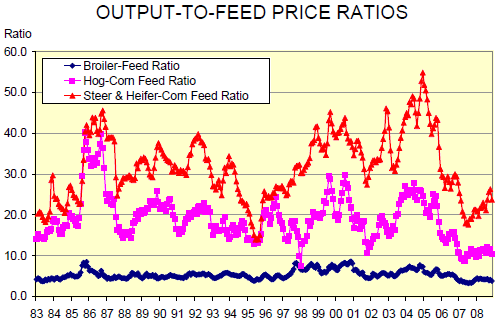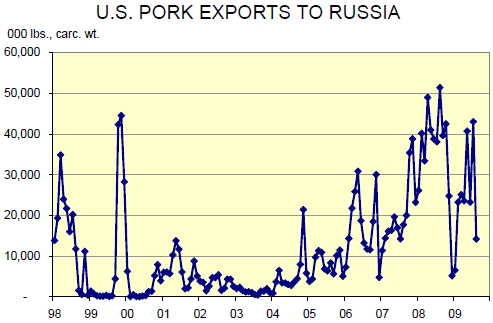



CME: Another Tough Month for Meat, Poultry Sectors
US - October was another tough month for all of the major meat/ poultry species in terms of profits, write Steve Meyer and Len Steiner.USDA’s monthly output-to-feed price ratios, released as part of the Agricultural Price report on Friday, showed a decline in the ratios for steers & heifers, hogs and broilers. Monthly data dating back to 1993 is shown in the graph below.

After climbing to 26.3 in September, its highest level in nearly 2 years, the steer & heifer-corn ratio fell by 2.6 points to 23.7 in October. The setback does not suggest a change in the general upward trend of the ratio. That trend dates back to some of the lowest observations on record during the summer of 2008 when corn prices reached record highs. The ratio remains short of levels that would suggest financial health for cattle feeders but the gap is narrowing due to lowercost feeder cattle reaching market weights.
The hog-corn ratio fell to 10.5 in October. That is 9.5 per cent lower than September’s ratio of 11.6. The October ratio is the lowest since January. Note that this ratio has generally followed the “hog cycle” in past years and usually had well –defined and short-lived bottoms. Not so this time as the ratio has languished hear 10 for two years.
The broiler-feed ratio declined by 7.3 per cent in October to 3.8, its lowest level since September ‘08. Note that the broiler-feed ratio uses 58 lbs. of corn and 42 lbs. of soybean meal as its feed component, reflecting the higher importance of soybean meal in chicken diets and production costs.
It is interesting to note that the broiler-feed ratio has shown the same cyclical turning points as the hog-corn ratio cycle since the mid-1990s. This correlation agrees with National Pork Board research that showed a much higher cross-price elasticity for pork and chicken at the retail level during those years. “Pork: The Other White Meat” apparently did move pork closer to chicken at retail.
CME Lean Hogs futures prices rose again, with the exception of the nearby December ‘09 and the October ‘10 contracts, on Friday. Several factors have been positive to Lean Hogs in recent weeks. First, pork cutout values have increased over $4/cwt over the past three weeks, including a gain of $1.73/cwt. or 3 per cent last week. FI hog slaughter has been 2.1 per cent below year-ago levels during those four weeks, very close (only 0.5 per cent below) to the levels expected from the September Hogs and Pigs Report. Pork demand appears to have picked up a bit with hams, bellies and trimmings all making nice gains last week. Some of that strength could be anticipation of renewed exports to Russia in the wake of a growing African swine fever outbreak that severely threatens Russia’s stated goal of becoming self-sufficient for pork by 2012. Most industry observers believe that was a long-shot to begin with, especially after oil prices fell last year. Higher oil prices and the renewed capital inflows they trigger for Russia had rekindled the self-sufficiency hope but this disease outbreak will be both damaging and difficult to control. The UN’s Food and Agricultural Organization (FAO) has warned that the disease could spread to the EU or China. The final factor that has helped Lean Hog prices was the rebalancing of commodity index funds to reduce positions in grains and hold more of other ag commodities, including hogs and cattle.












